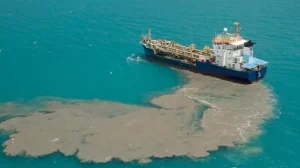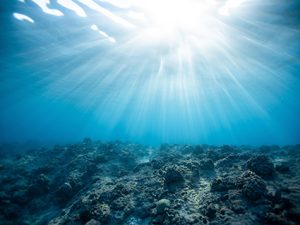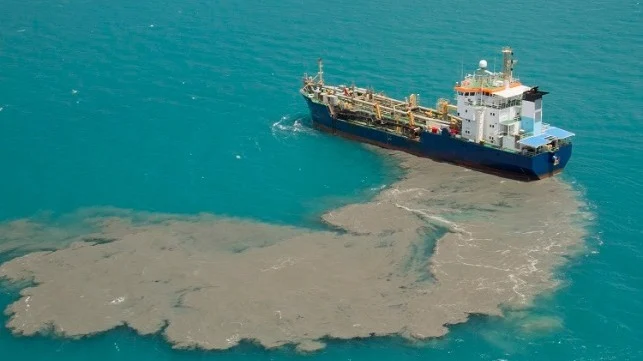Regulations for the prevention of pollution by sewage are contained in MARPOL Annex IV.

Sewage – the problem
The discharge of raw sewage into the sea can create a health hazard. Sewage can also lead to oxygen depletion and can be an obvious visual pollution in coastal areas – a major problem for countries with tourist industries.
The main sources of human-produced sewage are land-based – such as municipal sewers or treatment plants. However, the discharge of sewage into the sea from ships also contributes to marine pollution.
Annex IV of MARPOL
Annex IV contains a set of regulations regarding the discharge of sewage into the sea from ships, including regulations regarding the ships’ equipment and systems for the control of sewage discharge, the provision of port reception facilities for sewage, and requirements for survey and certification.
It is generally considered that on the high seas, the oceans are capable of assimilating and dealing with raw sewage through natural bacterial action. Therefore, the regulations in Annex IV of MARPOL prohibit the discharge of sewage into the sea within a specified distance from the nearest land, unless otherwise provided.
Governments are required to ensure the provision of adequate reception facilities at ports and terminals for the reception of sewage, without causing delay to ships.
The Annex entered into force on 27 September 2003. A revised Annex IV was adopted on 1 April 2004 and entered into force on 1 August 2005.
The revised Annex applies to ships, engaged in international voyages, of 400 gross tonnage and above or which are certified to carry more than 15 persons. The Annex requires ships to be equipped with either an approved sewage treatment plant or an approved sewage comminuting and disinfecting system or a sewage holding tank.
The discharge of sewage into the sea is prohibited, except when the ship has in operation an approved sewage treatment plant or when the ship is discharging comminuted and disinfected sewage using an approved system at a distance of more than three nautical miles from the nearest land. Sewage which is not comminuted or disinfected may be discharged at a distance of more than 12 nautical miles from the nearest land when the ship is en route and proceeding at not less than 4 knots, and the rate of discharge of untreated sewage shall be approved by the Administration (see resolution MEPC.157(55))

Sewage treatment plants for ships , source: https://www.wartsila.com/waw/waste-treatment/wastewater/sewage-treatment-plants
The MEPC also adopted the Recommendation on standards for the rate of discharge of untreated sewage from ships (resolution MEPC.157(55)).
Special Areas
In July 2011, MEPC 62 adopted, by resolution MEPC.200(62), the most recent amendment to MARPOL Annex IV, which entered into force on 1 January 2013. The amendment introduced, inter alia, a definition for Special Area as well as relevant requirements for the discharge of sewage from passenger ships in Special Areas and for port reception facilities.
The discharge of sewage from passenger ships within a Special Area is generally be prohibited under the new regulations, except when the ship has in operation an approved sewage treatment plant which has been certified by the Administration (see resolution MEPC.227(64)). The sewage treatment plant installed on a passenger ship intending to discharge sewage effluent in Special Areas should additionally meet the nitrogen and phosphorus removal standard when tested for its Certificate of Type Approval by the Administration (resolution MEPC.227(64), section 4.2).
Currently, the Baltic Sea area is the only Special Area under Annex IV. In accordance with resolution MEPC.275(69), the discharge requirements for Special Areas in regulation 11.3 of MARPOL Annex IV for the Baltic Sea Special Area shall take effect:
- on 1 June 2019, for new passenger ships[1];
- on 1 June 2021, for existing passenger ships[1] other than those specified in .3; and
- on 1 June 2023, for existing passenger ships en route directly to or from a port located outside the special area and to or from a port located east of longitude 28˚10′ E within the special area that do not make any other port calls within the special area.

Amendment to treaty on dumping of waste at sea will remove sewage sludge from list of wastes which may be given dumping permit.
Parties to the treaties which regulate the dumping of wastes at sea have adopted an amendment to ensure that the dumping of sewage sludge at sea would be prohibited worldwide.
The amendment to the London Protocol will remove sewage sludge from the list of permissible wastes – wastes which may be considered for dumping at sea.
The amendment was adopted by the 44th Consultative Meeting of Contracting Parties to the London Convention and the 17th Meeting of Contracting Parties to the London Protocol (LC 44/LP 17), which met at the international Maritime Organization (IMO) Headquarters from 3-7 October 2022. IMO is the Secretariat for both treaties.
The amendment will enter into force for each Contracting Party immediately on notification of its acceptance, or 100 days after the date of the adoption if that is later.
Sewage sludge is a waste that has been considered for dumping at sea under both the London Convention and London Protocol. Decades ago, a substantial volumes of sewage sludge was permitted to be dumped at sea. However, the London Convention and Protocol parties previously commissioned a world-wide review of current practices of managing or dumping sewage sludge at sea. The last meeting concluded that the practice had declined considerably over recent decades, that it was already prohibited under many regional conventions and through domestic legislation, and that alternatives existed for the use of the sewage sludge.
The Contracting Parties agreed that there was sufficient evidence and justification for amending Annex 1 of the London Protocol to remove sewage sludge from the list of permissible wastes. The proposal to amend the treaty was submitted by the Republic of Korea and Mexico.
Under the London Protocol all dumping is prohibited, except for possibly acceptable wastes on the so-called “reverse list” (Annex 1). The list of materials which may be considered for dumping at sea will now include: dredged material (the bulk of material given permits); fish wastes; inert, inorganic geological material; specific bulky items; vessels and platforms or other manmade structures at sea; organic material of natural origin; and carbon dioxide (CO2) streams from carbon dioxide capture processes.
Marine geoengineering techniques identified for further evaluation
The meeting agreed a statement on marine geoengineering.
Read more here.
50 years of the London Convention
In 2022, IMO is marking 50 years since the adoption of the London Convention. The adoption of the Convention was a major achievement, which, along with the 1972 United Nations Conference on the Environment in Stockholm, constituted the first steps to truly put the environment at centre stage and take responsibility for the harm humans have done to the ocean.
Download infographic illustrating the main steps taken under the London Convention since 1972.
The purpose of the London Convention is to control all sources of marine pollution and prevent pollution of the sea through regulation of dumping into the sea of waste materials. A so-called “black- and grey-list” approach is applied for wastes, which can be considered for disposal at sea according to the hazard they present to the environment. For the blacklist items dumping is prohibited. Dumping of the grey-listed materials requires a special permit from a designated national authority under strict control and provided certain conditions are met. All other materials or substances can be dumped after a general permit has been issued.
The purpose of the Protocol is similar to that of the Convention, but the Protocol is more restrictive: application of a “precautionary approach” is included as a general obligation and a “reverse list” approach is adopted, which implies that all dumping is prohibited unless explicitly permitted.
The London Protocol entered into force on 24 March 2006. The London Protocol has 53 Parties to the Protocol. (Read more here).
Conference – Protecting the Ocean – Moving forward at 50: London Convention & Stockholm Declaration
IMO and the World Maritime University (WMU) are holding a joint academic conference (10-13 October) to discuss ocean and climate related topics under the framework of the London Convention and Stockholm Declaration’s 50th anniversaries. Read more here.
Reference: IMO

